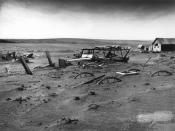Soil erosion is not one of the most sought after conservation movements today. Today's main focus is energy and environmental concerns. Soil erosion is significant, however, for various reasons. Currently, the Mississippi River is altering it natural course due to soil deposits from the northern portion. Additionally, soil erosion affects farming and pollution. Soil erosion can occur from winds, water and improper farming techniques. People are less connected to soil then in history. Soil is simply a resource necessary for crop production and for building structures. We take it for granted and fail to notice it is disappearing. About 6 metric tons of soil coming off of 2.5 acres would reduce the topsoil level by only 1 millimeter. On the other hand, soil formation may take between 200 and 1,000 years to form one inch of topsoil. Under natural conditions, soil is virtually a non-renewable resource.
Soil erosion in agricultural systems is a very important problem to manage.
The productive layer of dirt is called the humus or topsoil. If this layer is eroded away, then the ground is very unproductive in producing crops. High winds can blow away loose soils from flat or hilly terrain. Water erosion generally occurs only on slopes, and its severity increases with the severity of the slope. In the Midwest much of the wind erosion occurs in winter when the ground is frozen, but the upper most soil layer is dry and loose. Water erosion occurs during the spring with the thawing and melting action of the snow.
Soil generally consists of a large mineral component and a small amount of organic material, plus water and air. The mineral content is bedrock, which is broken down into particles by various chemical reactions and from water erosion. Decaying material on the surface and dead roots...


